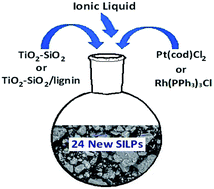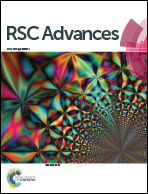SILP materials based on TiO2–SiO2 and TiO2–SiO2/lignin supports as new catalytic materials for hydrosilylation reaction – synthesis, physicochemical characterization and catalysis†
Abstract
The oxide system TiO2–SiO2 as well as a TiO2–SiO2/lignin system have been obtained by the sol–gel synthesis method and applied as supports in Supported Ionic Liquid Phase (SILP) materials. In total 24 SILP systems were obtained with ionic liquids containing imidazolium, pyridinium, phosphonium or sulfonic cations and bis(trifluoromethylsulfonyl)imide or methylsulfate anions, and homogeneous complexes of rhodium or platinum as the active phase. The supports and catalytic materials were subjected to thorough characterization by elemental analysis, XRD, SEM-EDX, IR, and TGA, and their particle size distribution and porous properties were assessed. The new SILP materials were used in hydrosilylation of 1-octene with 1,1,1,3,5,5,5-heptamethyltrisiloxane. The effectiveness of hydrosilylation reaction catalyzed by the obtained SILP materials for the polar and nonpolar reagents was assessed. All the catalytically active materials were proved to be easy to isolate and reuse, and the best SILP systems have been shown to be active in 10 or more subsequent catalytic cycles.



 Please wait while we load your content...
Please wait while we load your content...